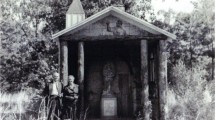Abstract
This introduction discusses both the western cultural context of, and research issues behind, the following three articles on institutions founded to house the poor in Holland, England, and their American colonies. It also discusses the connections between this volume on colonial-era institutions for the poor and the previous volume on nineteenth century asylums and prisons.
Similar content being viewed by others
REFERENCES CITED
Ashton, T. S. (1976). The Industrial Revolution 1760-1830, Oxford University Press, London.
Bell, E. L. (1993). Historical Archaeology at the Hudson Poor Farm Cemetery. Occasional Publications in Archaeology and History No. 5, Massachusetts Historical Commission, Boston.
Casella, E. C. (2001). To watch or restrain: female convict prisons in 19th-century Tasmania. International Journal of Historical Archaeology 5(1): 45-72.
Elia, R. J., and Wesolowsky, A. B. (eds.) (1991). Archaeological Investigations at the Uxbridge Almshouse Burial Ground in Uxbridge, Massachusetts. British Archaeological Reports International Series No. 564. Tempus Reparatum, Oxford, England.
Fraser, D. (1978). The Evolution of the British Welfare State: A History of Social Policy Since the Industrial Revolution, Macmillan, London.
Garman, James C., and Russo, Paul A. (1999). “A Disregard of Every Sentiment of Humanity”: The town farm and class realignment in nineteenth-century rural NewEngland. Historical Archaeology 33(1): 118-35.
Goffman, E. (1970). Asylums: Essays on the Social Situation of Mental Patients and Other Inmates, Aldine, Chicago.
Huey, P. R. (1991). The archaeology of Fort Orange and Beverwijck. In Zeller, N. A.M. (ed.), A Beautiful and Fruitful Place: Selected Rensselaerswijck Seminar Papers, New Netherland Publishing, Albany, New York, pp. 327-349.
Humphreys, R. (1995). Sin, Organized Charity and the Poor Law in Victorian England, St. Martin's Press, New York.
Ignatieff, M. (1978). A Just Measure of Pain: The Penitentiary in the Industrial Revolution 1750-1850, Columbia University Press, N ew York.
Katz, M. B. (1986). In the Shadow of the Poorhouse, Basic Books, New York.
Knott, J. (1986). Popular Opposition to the 1834 Poor Law, St. Martin's Press, New York.
Lucas, G. (1999). The archaeology of the workhouse: The changing uses of the workhouse buildings at St. Mary's, Southhampton. In Tarlow, S., and West, S. (eds.), The Familiar Past? Archaeologies of Later Historical Britain, Routledge, London, pp. 125-39.
Megaw, V. (1986). Adelaide's Destitute Asylum: a cautionary tale of rescue archaeology and confrontation politics. In Ward, G. K. (ed.), Archaeology at ANZAAS, Canberra Archaeological Society, Canberra, pp. 64-73.
Mencher, S. (1974). Poor Law to Poverty Program: Economic Security Policy in Britain and the United States, University of Pittsburgh Press, Pittsburgh.
Midwinter, E. (1994). The Development of Social Welfare in Britain, Open University Press, Buckingham.
Piddock, S. (2001). An irregular and inconvenient pile of buildings: The Destitute Asylum of Adelaide, South Australia, and the Englishworkhouse. International Journal of Historical Archaeology 5(1): 73-96.
Rothman, D. J. (1990). The Discovery of the Asylum: Social Order and Disorder in the New Republic, Little Brown, Boston.
Spencer-Wood, S. M. (1999). Research framework and questions. In Strauss, A. E., and Spencer-Wood, S. M. Phase II Archaeological Site Examination at the Artist's Guild/Old Poor House Building in Falmouth, Massachusetts. Report submitted to Massachusetts Historical Commission, permit #1769.
Spencer-Wood, S. M., and Baugher, S. (2001). Introduction and historical context for the archaeology of institutions of reform. Part I: asylums. International Journal of Historical Archaeology 5(1): 3-17.
Wertheimer, B. M. (1977). We Were There: The Story of Working Women in America, Pantheon Books, New York.
Author information
Authors and Affiliations
Rights and permissions
About this article
Cite this article
Spencer-Wood, S.M. Introduction and Historical Context to the Archaeology of Seventeenth and Eighteenth Century Almshouses. International Journal of Historical Archaeology 5, 115–122 (2001). https://doi.org/10.1023/A:1011317109050
Issue Date:
DOI: https://doi.org/10.1023/A:1011317109050




